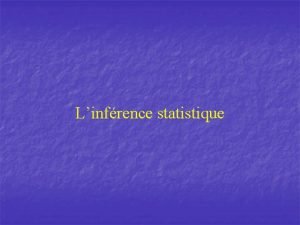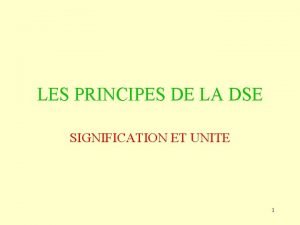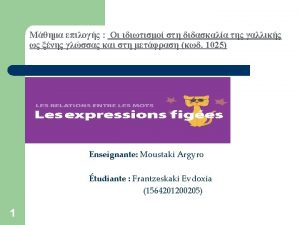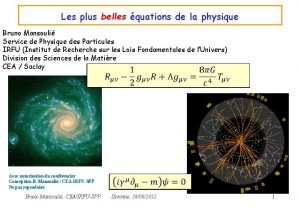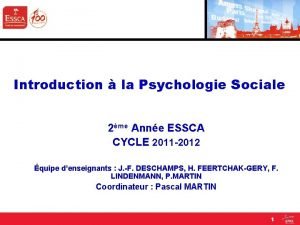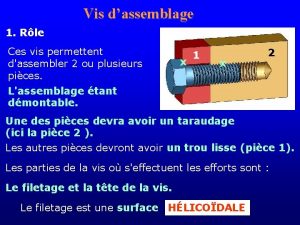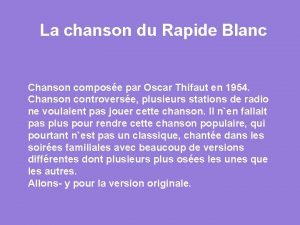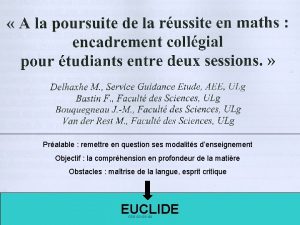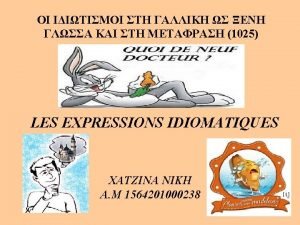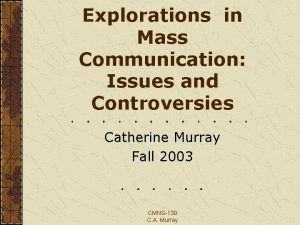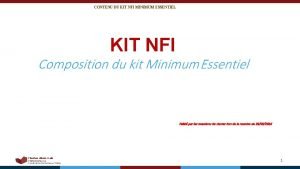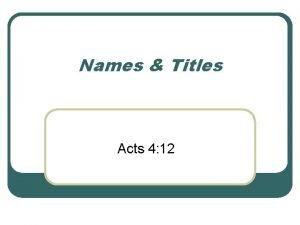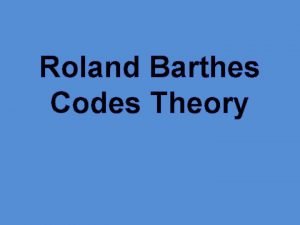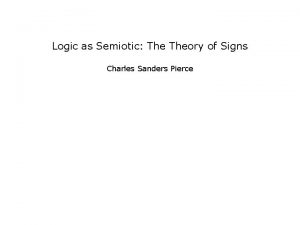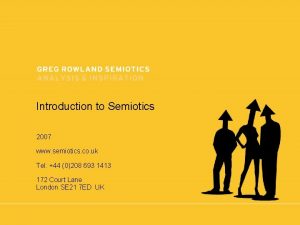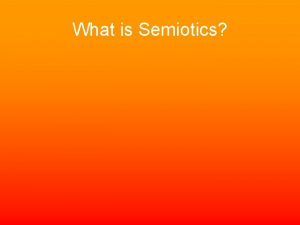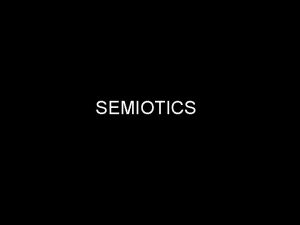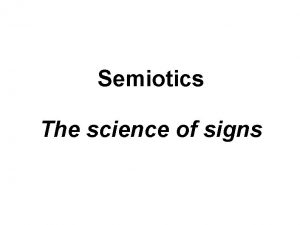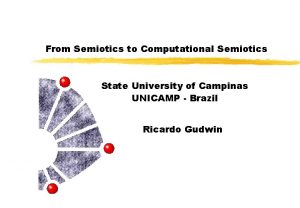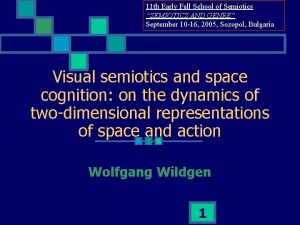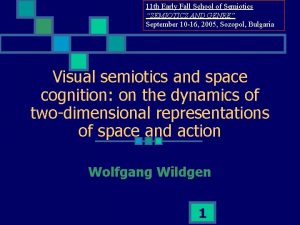What is Semiotics Semiotics The study of signification





































































- Slides: 69

What is Semiotics?

Semiotics • The study of – signification and communication – how meaning is constructed and understood – how signification changes in different contexts

Semiotics • Ferdinand de Saussure (“so-SIR”) (1857 -1913) – “It is possible to conceive of a science which studies the role of signs as part of social life. It would form part of social psychology, and hence of general psychology. We shall call it semiology (from the Greek semeîon, 'sign'). It would investigate the nature of signs and the laws governing them. ”

What is a Sign?

Sign • A sign is an entity which signifies another entity.

Sign • • • A sign is an entity which signifies another entity. We make meanings through our creation and interpretation of signs. Charles Sanders Peirce (“purse”) (1839 – 1914)

Sign • Whether something is a sign depends on a sentient entity ascribing it with meaning.

Sign • Whether something is a sign depends on a sentient entity ascribing it with meaning.

Sign • Whether something is a sign depends on a sentient entity ascribing it with meaning. “leaf”

Sign • Whether something is a sign depends on a sentient entity ascribing it with meaning. ?

Sign • Nothing is a sign unless it is interpreted as a sign. • Anything can be a sign as long as it is interpreted as signifying something by a sentient being.

Koko the Gorilla (view video)

Dyadic Model (Saussure) What are the two components of a Sign? ? ?

Dyadic Model (Saussure) Components of a Signified Signifier

Dyadic Model (Saussure) Components of a Signified is psychological Signifier is physical, sensual

Dyadic Model (Saussure) Commonsense dictates that the signified, the concept, is primary. Signified is psychological Signifier is physical, sensual

Dyadic Model (Saussure) But many contemporary theorists consider the signifier, the medium of expression, just as important. Signified is psychological Signifier is physical, sensual

Semiotics is about a System of Meaning • Signs don’t have an essential or intrinsic connection to nature.

Semiotics is about a System of Meaning • Signs don’t have an essential or intrinsic connection to nature. • Meaning is structural and relational rather than referential.

Semiotics is about a System of Meaning • Signs don’t have an essential or intrinsic connection to nature. • Meaning is structural and relational rather than referential. • Signs refer primarily to each other.

Semiotics is about a System of Meaning • Signs don’t have an essential or intrinsic connection to nature. • Meaning is structural and relational rather than referential. • Signs refer primarily to each other. • Signs only make sense as part of a formal, generalized and abstract system.

Semiotics is about a System of Meaning • The word “cat” only makes sense in relation to other words: – – – – “dog” “animal” “pet” “owner” “cute” “purr” “lick” “hunt”

Semiotics is about a System of Meaning “purr” “cute” “owner” “lick” “cat” “hunt” “animal” “dog”

Semiotics is about a System of Meaning • No sign can make sense on its own but only in relation to other signs.

Semiotics is about a System of Meaning • No sign can make sense on its own but only in relation to other signs. • The meaning of signs is in their systematic relation to each other rather than deriving from any inherent features of signifiers or any reference to material things.

Semiotics is about a System of Meaning The word “cat” has more in common with other words than it does an actual cat, or whatever a ? ? ? may actually be.

Language is Binaristic and Negative • • • Cat vs. Dog Man vs. Woman Nature vs. Culture Good vs. Evil Yes vs. No Black vs. White 0 vs. 1 Life vs. Death Gay vs. Straight Up vs. Down • • Cold vs. Hot Happy vs. Sad Sleep vs. Awake Free vs. Pay Pretty vs. Ugly West vs. East Paper vs. Plastic Republican vs. Democrat • Healthy vs. Sick • Few vs. Many

Things are defined not by what they are, but by what they are not.

Things are defined not by what they are, but by what they are not. “red”

Most of the information communicated is actually negative. “red”

Linguistic Signs are Immaterial (Saussure) • Word signifiers have no material value magically embedded in their sounds or appearance.

Linguistic Signs are Immaterial (Saussure) • Word signifiers have no material value magically embedded in their sounds or appearance. – This immateriality is their value. – If linguistic signs draw attention to their materiality this hinders their communicative transparency. – New words can be invented or imported as needed

Dyadic Model (Saussure) Signified is psychological Signifier is physical, sensual

Triadic Model (Peirce) Object in the real world or speaker’s mind Signified is psychological Signifier is physical, sensual

Triadic Model (Peirce) Object in the real world or speaker’s mind Interpretant is meaning from decoding representamen Representamen is physical, sensual

Three ways signs represent objects (Peirce) • Symbol • Icon • Index

Three ways signs represent objects (Peirce) • Symbol – Arbitrary or purely conventional – 100% needs to be learned – language in general, alphabet, punctuation marks, numbers, Morse code, traffic lights • Icon • Index

Three ways signs represent objects (Peirce) • Symbol – Arbitrary or purely conventional – 100% needs to be learned – language in general, alphabet, punctuation marks, numbers, Morse code, traffic lights • Icon – Resembling or imitating the signified – similar in some quality – portrait, cartoon, onomatopoeia, metaphors, sound effects imitative gestures • Index

Three ways signs represent objects (Peirce) • Symbol – Arbitrary or purely conventional – 100% needs to be learned – language in general, alphabet, punctuation marks, numbers, Morse code, traffic lights • Icon – Resembling or imitating the signified – similar in some quality – portrait, cartoon, onomatopoeia, metaphors, sound effects imitative gestures • Index – existential connection to the signified – evidence, smoke, footprints, pain, thermometer, clock, knock on a door, photograph, handwriting,

Three ways signs represent objects (Peirce) • Symbol • Icon • Index Signs can be one, two or all three of these at once.

What are some Symbols?

What are some Symbols? Words

What are some Icons?

What are some Icons? “Chirp chirp” “miu miu” “vroooom”

What are each of these?

What are each of these? Symbols Icons Symbol Icon of a real-world symbol (street sign)

What are some Indices? (plural of index)

What are some Indices? (plural of index)

Semiotic Analysis

Semiotic Analysis

Semiotic Analysis Olympic Style Guide for Beijing Citizens (for foreigners to interpret Chinese people positively)

Semiotic Analysis Olympic Style Guide for Beijing Citizens • No wearing pajamas in public

Semiotic Analysis Olympic Style Guide for Beijing Citizens • No wearing pajamas in public Westerners may read the person as crazy, or the culture doesn’t respect personal boundaries and privacy. The Chinese government recognized that Westerners will read the pajamas incorrectly.

Semiotic Analysis Olympic Style Guide for Beijing Citizens • No more than three color groups in your clothing. • No white socks with black leather shoes • No public displays of affection • When standing toes should point outwards • Handshakes should not last more than 3 seconds

Semiotic Analysis What are the intended signifieds?

Semiotic Analysis What are the intended signifieds? • • • Man Sexy Healthy / Ripped Calvin Klein brand Comfortable Virility “Package” Inadequacy? ? ? Jealousy? ? ? Fear? ? ?

Semiotic Analysis What are potential unintended signifieds?

Semiotic Analysis What are potential unintended signifieds? • • • Homoerotic? ? ? Corporate Propaganda “Douche bag” Alienated (from brand)

Semiotic Analysis How is the signifier shaping the signified?

Semiotic Analysis How is the signifier shaping the signified? • Black and white – form and mass rather than color – authenticity

Semiotic Analysis

Semiotic Analysis Transcoding (the signified)

Semiotic Analysis Transcoding (the signified) “Black” (“Black is Beautiful” from the 1960 s) “Nigger” “Queer” “Bitch” Minority groups often appropriate the language of oppression to assert power

“The CD cover of his album Put Yo Hood Up (2001) shows Lil’ Jon clad in a pair of black rubber coveralls, his open-mouthed expression of rage and intensity augmented by the added effect of gold teeth, sunglasses, and long dreadlocks, creating a general impression of a demented slaughterhouse worker or other grotesque. The draping of the rebel flag around his shoulders in the picture, far from constituting an endorsement, communicates the hostile occupation of a symbol. The cover image seems the worst nightmare of a white supremacist, a demonic, superpowered black man appropriating, occupying, and defiling the treasured symbol of Dixie. ” http: //www. southernspaces. org/contents/2008/miller/9 a. htm

Semiotic Analysis I'm Sorry Miss Jackson "I wear the belt for southern pride and to rebel. . I don't take the Confederate flag that serious as far as the racial part is concerned. " Andre 3000 of Out. Kast

Semiotic Analysis Trans-coding (the signified) Other examples?

Semiotic Analysis

Semiotic Analysis

Semiotic Analysis
 Cdmt signification
Cdmt signification Wvta signification
Wvta signification Infrence
Infrence Signification process
Signification process Dse signification
Dse signification Pictogramme je flambe
Pictogramme je flambe Sirh signification
Sirh signification être blanc comme neige signification
être blanc comme neige signification Usurpature
Usurpature Irfu signification
Irfu signification Yvonne signification
Yvonne signification Psaumes 119:105
Psaumes 119:105 ø signification
ø signification Significane of mitosis
Significane of mitosis Essca signification
Essca signification Pessoas vis
Pessoas vis Image en miroir ecg définition
Image en miroir ecg définition Signification
Signification Awingna han définition
Awingna han définition Pralable
Pralable Pleurer comme une madeleine signification
Pleurer comme une madeleine signification Domenico doria
Domenico doria Wvta signification
Wvta signification Image en miroir ecg signification
Image en miroir ecg signification Cont'd signification
Cont'd signification Kit nfi signification
Kit nfi signification Abram signification
Abram signification Semiotics
Semiotics Barthes codes
Barthes codes Semiotics
Semiotics Semiotics
Semiotics Myth barthes examples
Myth barthes examples Anaphone definition
Anaphone definition Semiotics
Semiotics Greg rowland semiotics
Greg rowland semiotics Types of media codes
Types of media codes Saussure dyadic model
Saussure dyadic model Connotation of shark
Connotation of shark Hình ảnh bộ gõ cơ thể búng tay
Hình ảnh bộ gõ cơ thể búng tay Thế nào là mạng điện lắp đặt kiểu nổi
Thế nào là mạng điện lắp đặt kiểu nổi Dot
Dot Vẽ hình chiếu đứng bằng cạnh của vật thể
Vẽ hình chiếu đứng bằng cạnh của vật thể Biện pháp chống mỏi cơ
Biện pháp chống mỏi cơ Phản ứng thế ankan
Phản ứng thế ankan Chó sói
Chó sói Các môn thể thao bắt đầu bằng tiếng chạy
Các môn thể thao bắt đầu bằng tiếng chạy Sự nuôi và dạy con của hươu
Sự nuôi và dạy con của hươu Thiếu nhi thế giới liên hoan
Thiếu nhi thế giới liên hoan điện thế nghỉ
điện thế nghỉ Một số thể thơ truyền thống
Một số thể thơ truyền thống Trời xanh đây là của chúng ta thể thơ
Trời xanh đây là của chúng ta thể thơ Số nguyên tố là gì
Số nguyên tố là gì Phối cảnh
Phối cảnh Các châu lục và đại dương trên thế giới
Các châu lục và đại dương trên thế giới Thang điểm glasgow
Thang điểm glasgow Thế nào là hệ số cao nhất
Thế nào là hệ số cao nhất Sơ đồ cơ thể người
Sơ đồ cơ thể người ưu thế lai là gì
ưu thế lai là gì Tư thế ngồi viết
Tư thế ngồi viết Cái miệng nó xinh thế
Cái miệng nó xinh thế đặc điểm cơ thể của người tối cổ
đặc điểm cơ thể của người tối cổ Mật thư anh em như thể tay chân
Mật thư anh em như thể tay chân Bổ thể
Bổ thể Tư thế ngồi viết
Tư thế ngồi viết Thẻ vin
Thẻ vin Thể thơ truyền thống
Thể thơ truyền thống Các châu lục và đại dương trên thế giới
Các châu lục và đại dương trên thế giới Chúa sống lại
Chúa sống lại Từ ngữ thể hiện lòng nhân hậu
Từ ngữ thể hiện lòng nhân hậu


